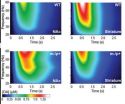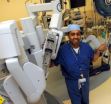(Press-News.org) CHAPEL HILL, N.C. – Last year a clinical trial of L-DOPA -- a mainstay of Parkinson's disease therapy -- was launched for Angelman syndrome, a rare intellectual disorder that shares similar motor symptoms such as tremors and difficulty with balance. The clinical trial is based on a 10-year-old case report showing benefit with the drug, but few studies since have explored the neurological justification for using L-DOPA to treat parkinsonian features in Angelman syndrome.
New research from the University of North Carolina School of Medicine, conducted in animal models of the disorder, now provides justification for this therapeutic approach. The study, published online ahead of print on Nov. 12 by the Journal of Clinical Investigation, suggests that L-DOPA could compensate for a loss of the neurochemical dopamine in the brain's motor pathways and improve motor symptoms. However, it also indicates that the drug could add to an already increased amount of dopamine in the brain's reward pathways and thus have unanticipated consequences on emotion and attention.
"The results were extremely surprising, because we don't know of any other disorder where dopamine is affected one way in one brain pathway and the opposite way in another," said Benjamin D. Philpot, PhD, associate professor of cell biology and physiology at UNC.
"If what we see in humans mirrors what we see in mice, then it does provide some optimism that L-DOPA might provide benefit for tremor," said C.J. Malanga, MD, PhD, associate professor of neurology at UNC. "But it also raises caution that researchers might want to consider assessing other aspects of Angelman syndrome that might be affected by dopamine -- not just motor symptoms but also other neuropsychiatric features." Malanga and Philpot are senior authors of the study.
Angelman syndrome affects about every one out of every 15,000 people. Individuals with the disorder have minimal verbal communication – some never speak a single word – as well as seizures and motor problems. It is caused by defects in UBE3A, a gene involved in the development of the brain's wiring. Much of what has been learned about this gene has come from a mouse model lacking UBE3A.
Philpot and Malanga decided to use these Angelman syndrome model mice to explore how dopamine is affected in Angelman syndrome. Dopamine is a well-known neurotransmitter, one of many chemicals responsible for transmitting signals between neurons in the brain. In their experiments, the researchers found that the behavioral deficits seen in the Angelman syndrome model were not due to the loss of dopamine-producing brain cells -- as in Parkinson's disease -- or reduced production of the important neurochemical.
Rather, they found that it was associated with differences in release of the dopamine molecule from brain cells. Specifically, dopamine release was decreased in one brain pathway -- the motor or nigrostriatal pathway -- and increased in another -- the reward or mesolimbic pathway. But instead of having a greater effect on reward, dopamine also appeared to be less effective at motivating behavior in these mice.
"One of the interesting features of people with Angelman syndrome is that they generally have a very happy disposition and a lower threshold for humor. It is interesting that we found this effect in the reward pathway, because it could provide a biological basis for this happy disposition," said Philpot.
Malanga cautions that this happy disposition, as well as the lack of communication skills, might make it hard for researchers to tell if their Angelman syndrome patients are experiencing negative consequences of an altered reward pathway, such as changes in mood or compulsive behaviors. Therefore, he recommends that clinical trials assess many different outcome measures to ensure that L-DOPA treatment does not lead to unanticipated outcomes.
INFORMATION:
The research was funded by the National Institutes of Health, the Simons Foundation, the Angelman Syndrome Foundation and Autism Speaks. Study co-authors from UNC were Thorfinn T. Riday; Elyse C. Dankoski; Michael C. Krouse; Eric W. Fish, PhD; Paul L. Walsh; Ji Eun Han; Clyde W. Hodge, PhD; and R. Mark Wightman, PhD.
Study justifies L-DOPA therapy for Angelman syndrome
2012-11-12
ELSE PRESS RELEASES FROM THIS DATE:
Patients shy away from asking healthcare workers to wash hands
2012-11-12
CHICAGO (November 12, 2012) – According to a new study published online today, most patients at risk for healthcare-associated infections (HAIs) agree that healthcare workers should be reminded to wash their hands, but little more than half would feel comfortable asking their physicians to wash. The study is published in the December issue of Infection Control and Hospital Epidemiology, the journal of the Society for Healthcare Epidemiology of America. The study points to the need for patient empowerment to improve hand hygiene of healthcare workers.
Researchers from ...
PI3-kinase and PARP inhibitor combo may offer new treatment option for triple-neg breast cancers
2012-11-12
PHILADELPHIA — The simultaneous inhibition of two separate and seemingly unrelated pathways could potentially provide an effective treatment for women with triple-negative breast cancer, according to results of two studies published in the November issue of Cancer Discovery, a journal of the American Association for Cancer Research.
Triple-negative breast cancers do not express three common targets of breast cancer treatments: the estrogen receptor, progesterone receptor and HER2/neu. As a result, women with triple-negative breast cancer have few treatment options. In ...
UNC, Vanderbilt discover a new live vaccine approach for SARS and novel coronaviruses
2012-11-12
Rapid mutation has long been considered a key to viral adaptation to environmental change. But in the case of the coronavirus responsible for deadly severe acute respiratory syndrome (SARS), collaborating researchers at the University of North Carolina and Vanderbilt University have found that accelerating the rate of mutations cripples the virus's ability to cause disease in animals. In addition, they say this finding may allow scientists to explore a new option for creating safer live vaccines.
A collaborative study, published Nov. 11 in Nature Medicine, demonstrates ...
Bringing measuring accuracy to radical treatment
2012-11-12
An international team of scientists working at the Plasma Technology research unit at Ghent University, Belgium, has determined for the first time the absolute density of active substances called radicals found in a state of matter known as plasma, in a study about to be published in EPJ D. These findings could have important implications for medicine—for example, for stimulating tissue regeneration, or to induce a targeted antiseptic effect in vivo without affecting neighbouring tissues.
Qing Xiong and colleagues utilised laser fluorescence spectroscopy (LIF), a detection ...
Duke Medicine news -- Genome sequencing of Burkitt Lymphoma reveals unique mutation
2012-11-12
DURHAM, N.C. – In the first broad genetic landscape mapped of a Burkitt lymphoma tumor, scientists at Duke Medicine and their collaborators identified 70 mutations, including several that had not previously been associated with cancer and a new one that was unique to the disease.
Findings from the genetic sequencing of Burkitt lymphoma, an aggressive form of lymphoma, could be used to develop new drugs or aim existing therapies at mutations known to be susceptible. The researchers published their findings online Sunday, Nov. 11, 2012, in the journal Nature Genetics.
"This ...
News from Annals of Internal Medicine
2012-11-12
Philadelphia, November 12, 2012 – A new article being published early online in Annals of Internal Medicine describes the diagnosis and treatment protocol established in a Roanoke, Va. hospital to care for dozens of patients presenting with suspected fungal meningitis related to contaminated epidural spinal injections. This unprecedented surge of patients seeking care for a rare central nervous system (CNS) infection required physicians to react quickly with little data to guide treatment decisions. The authors suggest that the data collected from these cases may fill information ...
Genetic link between pancreatitis and alcohol consumption, says Pitt team
2012-11-12
PITTSBURGH, Nov. 12, 2012 – A new study published online today in Nature Genetics reveals a genetic link between chronic pancreatitis and alcohol consumption. Researchers from the University of Pittsburgh School of Medicine and more than 25 other health centers across the United States found a genetic variant on chromosome X near the claudin-2 gene (CLDN2) that predicts which men who are heavy drinkers are at high risk of developing chronic pancreatitis.
This finding enables doctors to identify people with early signs of pancreatitis or an attack of acute pancreatitis ...
Job stress and mental health problems contribute to higher rates of physician suicide
2012-11-12
ANN ARBOR, Mich. — Doctors who commit suicide appear to be under-treated for mental health problems, despite their seemingly good access to health care, a new University of Michigan study shows.
Although more physicians than non-physicians in the study had known mental health problems prior to suicide, this didn't translate into a higher rate of antidepressant use, according to the study, which appears in General Hospital Psychiatry and provides a deeper look at why physicians may have a higher-than-average suicide rate.
Major depression is a known risk factor for ...
Robots enable scar-free hysterectomies for some women
2012-11-12
AUGUSTA, Ga. – The precision and three-dimensional view provided by robots can enable essentially scar-free surgery for some women needing hysterectomies, physicians report.
The case report in the Journal of Minimal Access Surgery is of a 46-year-old physically fit female with a history of excessive bleeding and benign growths on her uterus. Her surgery was performed through a two inch-long incision in the belly button, the thinnest part of the abdomen, using the robotic arms in a "chopstick" fashion, said Dr. John R. Lue, Chief of the Medical College of Georgia Section ...
Desecrated ancient temple sheds light on early power struggles at Tel Beth-Shemesh
2012-11-12
Tel Aviv University researchers have uncovered a unique 11th century BCE sacred compound at the site of Tel Beth-Shemesh, an ancient village that resisted the aggressive expansion of neighboring Philistines. The newly discovered sacred complex is comprised of an elevated, massive circular stone structure and an intricately constructed building characterized by a row of three flat, large round stones. Co-directors of the dig Prof. Shlomo Bunimovitz and Dr. Zvi Lederman of TAU's Sonia and Marco Nadler Institute of Archaeology say that this temple complex is unparalleled, ...

